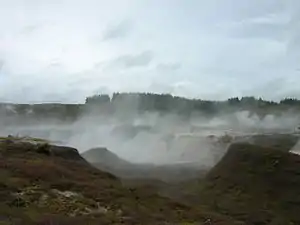Wairakei
Wairakei is a small settlement, and geothermal area a few kilometres north of Taupo, in the centre of the North Island of New Zealand, on the Waikato River. It is part of the Taupo Volcanic Zone and features several natural geysers, hot pools. boiling mud pools, and the Wairakei Power Station, a major geothermal electric power generating station.
Wairakei | |
|---|---|
Rural locality | |
 The Craters of the Moon, a steamfield close by, created by the use of geothermal energy changing the underground pressure situation. | |

| |
| Coordinates: 38.619°S 176.103°E | |
| Country | New Zealand |
| Region | Waikato |
| Territorial authority | Taupo District |
| Ward | Taupō-Kaingaroa |
| Population (2018) | |
| • Total | 510 |
| Postcode(s) | 3332 |
The station was the second large-scale geothermal facility worldwide, and was commissioned in 1958. It was listed in the book 70 Wonders Of The Modern World published in 2000 by Reader's Digest to record The Eventful 20th Century.[1]

The settlement, referred to as Wairakei Village, was constructed to house the workers of both the power station and the neighbouring Aratiatia hydro power station.
Demographics
| Year | Pop. | ±% p.a. |
|---|---|---|
| 2006 | 1,092 | — |
| 2013 | 1,152 | +0.77% |
| 2018 | 1,236 | +1.42% |
| Source: [2] | ||
The statistical area of Wairakei-Broadlands, which at 410 square kilometres is much larger than the town, had a population of 1,236 at the 2018 New Zealand census, an increase of 84 people (7.3%) since the 2013 census, and an increase of 144 people (13.2%) since the 2006 census. There were 387 households. There were 648 males and 588 females, giving a sex ratio of 1.1 males per female. The median age was 31.9 years (compared with 37.4 years nationally), with 315 people (25.5%) aged under 15 years, 261 (21.1%) aged 15 to 29, 555 (44.9%) aged 30 to 64, and 105 (8.5%) aged 65 or older.
Ethnicities were 74.8% European/Pākehā, 36.7% Māori, 4.4% Pacific peoples, 3.6% Asian, and 1.9% other ethnicities (totals add to more than 100% since people could identify with multiple ethnicities).
The proportion of people born overseas was 12.9%, compared with 27.1% nationally.
Although some people objected to giving their religion, 64.1% had no religion, 22.3% were Christian, 1.2% were Hindu, 0.2% were Muslim, 0.2% were Buddhist and 3.4% had other religions.
Of those at least 15 years old, 75 (8.1%) people had a bachelor or higher degree, and 210 (22.8%) people had no formal qualifications. The median income was $32,700, compared with $31,800 nationally. The employment status of those at least 15 was that 516 (56.0%) people were employed full-time, 138 (15.0%) were part-time, and 51 (5.5%) were unemployed.[2]
Wairakei Village had a population of 510 in the 2018 census, an increase of 57 since 2013. There were 270 males and 240 females. 246 people (48%) identified as Māori.[3]
Education
Wairakei School is a co-educational state primary school,[4][5] with a roll of 360 as of March 2020.[6][7] The school opened in 1959.[8]
Notable people
- Louise Rennison, lived here as a teenager[9]
External links
- Wairakei - information at Environment Waikato
- Wairakei Geyser (1933 article)
References
- Antony Mason, 70 Wonders Of The Modern World, ISBN 0-86449-376-2
- "Statistical area 1 dataset for 2018 Census". Statistics New Zealand. March 2020. Wairakei-Broadlands (188200). 2018 Census place summary: Wairakei-Broadlands
- "Age and sex by ethnic group (grouped total response), for census usually resident population counts, 2006, 2013, and 2018 Censuses (urban rural areas)". Statistics New Zealand. Retrieved 20 November 2020.
- "Wairakei School Official School Website". wairakei.school.nz.
- "Wairakei School Ministry of Education School Profile". educationcounts.govt.nz. Ministry of Education.
- "New Zealand Schools Directory". New Zealand Ministry of Education. Retrieved 26 April 2020.
- "Wairakei School Education Review Office Report". ero.govt.nz. Education Review Office.
- "History". Wairakei School. Retrieved 20 November 2020.
- "Louise Rennison". Louise Rennison.